|
Downloads *
Drummers Trivia *
Drummers Chat Rooms *
Rudiments *
Digital Music *
Knowledge Assessments *
TD Archives *
Drum Set Buyers Guide *
Bass-Player Jokes *
Assembling a Drum Set *
Parts of a Drum Set *
About HSID *
Video Troubleshooter
Bill Powelson's School of Drums
School of Drums
PRIVATE DRUM LESSON 11 E-M
"Polka, CutTime, 2/4, and Up-Tempo Jazz"

Polka, Cut-Time 2/4, and Up-Tempo Jazz
WARNING: Though the beats in this lesson appear simple in print
they will prove very frustrating to all but the rudiment freaks. You
will actually be executing single stroke and double stroke rolls
at extremely rapid tempos when performing these beat patterns. The
truth is, these beats are somewhat useless at slow tempos and seemingly
impossible at quick tempos for all but those who have devoted many hours
to the above mentioned rolls.
THE GOOD NEWS: There are easier substitute beat patterns that can be used
in place of these patterns. You might play a lifetime without these beats and never
have a problem. So, if they drive you crazy and leave you frustrated . . .
DON'T PANIC! You can put them on the back-burner for study at another
time.
MORE GOOD NEWS: Mastery of these patterns will automatically
help students develop enviable mastery with the specific rudiments
in question. In other words . . . you will be learning beats that will
also help you get a grip on those boring rudiments that always need so much additional
effort. With enough time and effort expended on these patterns you will enjoy greater
flexibility over-all around the kit. In essence you are mastering two very important
rudiments as you master these dancebeat rhythms. These beat patterns can help a
student develop the technical polish and control that will otherwise only occur as a result
of effort expended with rudimental repetition. This means that any effort you expend here
won't be wasted. Most of us need the rudimental practice anyway!
EVEN MORE GOOD NEWS: After many years of teaching these patterns I have developed
a stair-step process with these beats that will make the patterns appear
overly simple in the beginning stages . . . you will find uses for the simpler stages
and by using the easy forms at first, the more difficult stages will gradually develop and
grow over a period of time. One day, 6 months later . . . you will gravitate towards
the more difficult stages when your hands, feet and mind are ready. Even the difficult
stages are easy to comprehend but may be very difficult to play at extremely quick
tempos. The problem is that these beats are only valuable in quick tempos . . . they
aren't often used in slow tempos. This means you have to be fast with them, coming
out of the gate and that takes a lot of work.
All of the above discussion has been added to simply help you avoid being too hard on
yourself if you hit a brick wall here.
- Understand these patterns . . .
- Work on them as much and as long
as your patience will allow . . .
- DO NOT let this material discourage you!
Improvement will
occur with time. Move on to another topic . . . just prior to driving a
drumstick through your batter head in frustration. You could play 20 years
and make a Million Dollars without these beats. Don't let them bring you down.
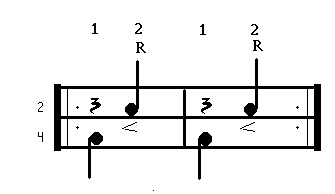
 EASY!!!!
This one is a piece of cake . . . and so simple, you will begin to wonder why
I am raving about all the difficulties. Remember, speed is at issue here. This is
about the fastest beat on the planet. When all else fails, we can still use this
easy, beat to keep the band in line. No drummer worth his salt would use this at
tempos slower than you will hear on this midi file. EASY!!!!
This one is a piece of cake . . . and so simple, you will begin to wonder why
I am raving about all the difficulties. Remember, speed is at issue here. This is
about the fastest beat on the planet. When all else fails, we can still use this
easy, beat to keep the band in line. No drummer worth his salt would use this at
tempos slower than you will hear on this midi file.
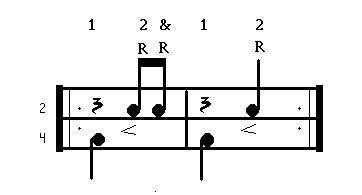
 The plot thickens . . .
Now we play a quick double right hand with every other repetition. The tempo
should remain the same. Notice the '<' accent mark below the backbeat. We
need to play that note a tad louder than all the rest. My dumb little midi file
maker had a problem with the accent and I had to fudge a little to get the sound
we need. I would love to use a real drum set here but regrettably, it is a major
gig, trying to get an acoustic drumset to make midi files. The plot thickens . . .
Now we play a quick double right hand with every other repetition. The tempo
should remain the same. Notice the '<' accent mark below the backbeat. We
need to play that note a tad louder than all the rest. My dumb little midi file
maker had a problem with the accent and I had to fudge a little to get the sound
we need. I would love to use a real drum set here but regrettably, it is a major
gig, trying to get an acoustic drumset to make midi files.
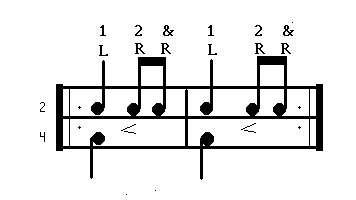
 NOW, add the left hand with
each downbeat. And yes . . . the tempo should remain the same as before. NOW, add the left hand with
each downbeat. And yes . . . the tempo should remain the same as before.
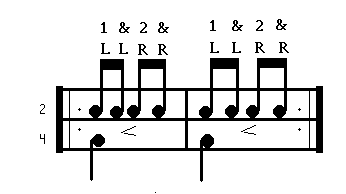
 This is the final product.
And . . . another name for this one might be 'The Train Beat'. What a dumb name,
haha. Why would they call it that? This is the final product.
And . . . another name for this one might be 'The Train Beat'. What a dumb name,
haha. Why would they call it that?
OK . . . I'm going to assume that two years have passed and you are playing the above
beat pattern at about twice the speed of the midi file. Grab your brushes and play around
with it. When played with brushes this beat pattern becomes a super
background rhythm for hundreds of smokin' jazz tunes . . . You will also hear it in Punk,
Rockabilly and Country & Western styles too.
Remember this as well, . . . each bass drum note could potentially be the beginning
or end of any of your previously studied fills. Try them all within this structure:
Singles, Triplets, Press Rolls . . . the works. Be able to play any of your routine fills
without losing tempo.
MORE!!!???
Yes . . . I can keep you busy another year or two by changing the stroke
pattern on these same beats. It may be easier for some of you to play this
as a Single Stroke pattern rather than a Double Stroke as it is written above.
A truly versatile drummer will be able to play it either way . . . and VERY fast.
HERE IT IS AGAIN,
AS A SINGLE STROKE PATTERN . . .
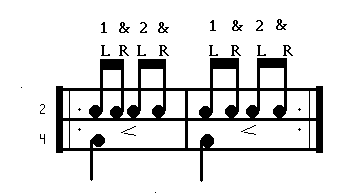
 Yes, it sounds the same,
but it is great to know the beat both ways . . . That way, as your hands
grow numb in the 30th minute of a jamming jazz tune . . . you can always
switch strokes in mid song, placing the stress on the opposite hand. Yes, it sounds the same,
but it is great to know the beat both ways . . . That way, as your hands
grow numb in the 30th minute of a jamming jazz tune . . . you can always
switch strokes in mid song, placing the stress on the opposite hand.
AS A PARTING THOUGHT . . . try reversing the hand you begin with.
In other words, rather than beginning the beat with the left hand as it is
written above . . . reverse it . . . and start with your right hand.

Copyright Bill Powelson 1996 all rights reserved.
| 


